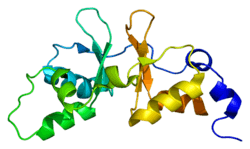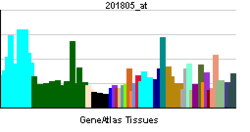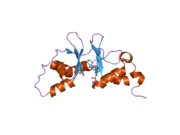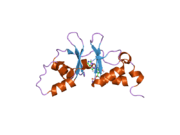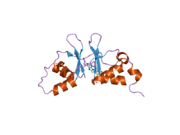PRKAG1
| View/Edit Human | View/Edit Mouse |
5'-AMP-activated protein kinase subunit gamma-1 is an enzyme that in humans is encoded by the PRKAG1 gene.[3][4][5]
The protein encoded by this gene is a regulatory subunit of the AMP-activated protein kinase (AMPK). AMPK is a heterotrimer consisting of an alpha catalytic subunit, and non-catalytic beta and gamma subunits. AMPK is an important energy-sensing enzyme that monitors cellular energy status. In response to cellular metabolic stresses, AMPK is activated, and thus phosphorylates and inactivates acetyl-CoA carboxylase (ACC) and beta-hydroxy beta-methylglutaryl-CoA reductase (HMGCR), key enzymes involved in regulating de novo biosynthesis of fatty acid and cholesterol. This subunit is one of the gamma regulatory subunits of AMPK. Alternatively spliced transcript variants encoding distinct isoforms have been observed.[5]
Interactions
PRKAG1 has been shown to interact with PRKAB2[6] and PRKAB1.[6]
References
- ↑ "Human PubMed Reference:".
- ↑ "Mouse PubMed Reference:".
- ↑ Stapleton D, Mitchelhill KI, Gao G, Widmer J, Michell BJ, Teh T, House CM, Fernandez CS, Cox T, Witters LA, Kemp BE (February 1996). "Mammalian AMP-activated protein kinase subfamily". J Biol Chem. 271 (2): 611–4. doi:10.1074/jbc.271.2.611. PMID 8557660.
- ↑ Gao G, Fernandez CS, Stapleton D, Auster AS, Widmer J, Dyck JR, Kemp BE, Witters LA (June 1996). "Non-catalytic beta- and gamma-subunit isoforms of the 5'-AMP-activated protein kinase". J Biol Chem. 271 (15): 8675–81. doi:10.1074/jbc.271.15.8675. PMID 8621499.
- 1 2 "Entrez Gene: PRKAG1 protein kinase, AMP-activated, gamma 1 non-catalytic subunit".
- 1 2 Cheung, P C; Salt I P; Davies S P; Hardie D G; Carling D (March 2000). "Characterization of AMP-activated protein kinase gamma-subunit isoforms and their role in AMP binding". Biochem. J. ENGLAND. 346 Pt 3 (3): 659–69. doi:10.1042/0264-6021:3460659. ISSN 0264-6021. PMC 1220898
 . PMID 10698692.
. PMID 10698692.
Further reading
- Hofmann B, Nishanian P, Baldwin RL, et al. (1991). "HIV inhibits the early steps of lymphocyte activation, including initiation of inositol phospholipid metabolism". J. Immunol. 145 (11): 3699–705. PMID 1978848.
- Beebe SJ, Oyen O, Sandberg M, et al. (1990). "Molecular cloning of a tissue-specific protein kinase (C gamma) from human testis--representing a third isoform for the catalytic subunit of cAMP-dependent protein kinase". Mol. Endocrinol. 4 (3): 465–75. doi:10.1210/mend-4-3-465. PMID 2342480.
- Hofmann B, Nishanian P, Nguyen T, et al. (1993). "Human immunodeficiency virus proteins induce the inhibitory cAMP/protein kinase A pathway in normal lymphocytes". Proc. Natl. Acad. Sci. U.S.A. 90 (14): 6676–80. doi:10.1073/pnas.90.14.6676. PMC 46995
 . PMID 7688126.
. PMID 7688126. - Hofmann B, Nishanian P, Fan J, et al. (1994). "HIV Gag p17 protein impairs proliferation of normal lymphocytes in vitro". AIDS. 8 (7): 1016–7. doi:10.1097/00002030-199407000-00025. PMID 7946090.
- Woods A, Cheung PC, Smith FC, et al. (1996). "Characterization of AMP-activated protein kinase beta and gamma subunits. Assembly of the heterotrimeric complex in vitro". J. Biol. Chem. 271 (17): 10282–90. doi:10.1074/jbc.271.48.30517. PMID 8626596.
- Dyck JR, Gao G, Widmer J, et al. (1996). "Regulation of 5'-AMP-activated protein kinase activity by the noncatalytic beta and gamma subunits". J. Biol. Chem. 271 (30): 17798–803. doi:10.1074/jbc.271.30.17798. PMID 8663446.
- Bonaldo MF, Lennon G, Soares MB (1997). "Normalization and subtraction: two approaches to facilitate gene discovery". Genome Res. 6 (9): 791–806. doi:10.1101/gr.6.9.791. PMID 8889548.
- Swingler S, Gallay P, Camaur D, et al. (1997). "The Nef protein of human immunodeficiency virus type 1 enhances serine phosphorylation of the viral matrix". J. Virol. 71 (6): 4372–7. PMC 191654
 . PMID 9151826.
. PMID 9151826. - Stapleton D, Woollatt E, Mitchelhill KI, et al. (1997). "AMP-activated protein kinase isoenzyme family: subunit structure and chromosomal location". FEBS Lett. 409 (3): 452–6. doi:10.1016/S0014-5793(97)00569-3. PMID 9224708.
- Chen P, Mayne M, Power C, Nath A (1997). "The Tat protein of HIV-1 induces tumor necrosis factor-alpha production. Implications for HIV-1-associated neurological diseases". J. Biol. Chem. 272 (36): 22385–8. doi:10.1074/jbc.272.36.22385. PMID 9278385.
- Reinton N, Haugen TB, Orstavik S, et al. (1998). "The gene encoding the C gamma catalytic subunit of cAMP-dependent protein kinase is a transcribed retroposon". Genomics. 49 (2): 290–7. doi:10.1006/geno.1998.5240. PMID 9598317.
- Zidovetzki R, Wang JL, Chen P, et al. (1998). "Human immunodeficiency virus Tat protein induces interleukin 6 mRNA expression in human brain endothelial cells via protein kinase C- and cAMP-dependent protein kinase pathways". AIDS Res. Hum. Retroviruses. 14 (10): 825–33. doi:10.1089/aid.1998.14.825. PMID 9671211.
- Mayne M, Bratanich AC, Chen P, et al. (1998). "HIV-1 tat molecular diversity and induction of TNF-alpha: implications for HIV-induced neurological disease". Neuroimmunomodulation. 5 (3–4): 184–92. doi:10.1159/000026336. PMID 9730685.
- Cheung PC, Salt IP, Davies SP, et al. (2000). "Characterization of AMP-activated protein kinase gamma-subunit isoforms and their role in AMP binding". Biochem. J. 346 Pt 3 (3): 659–69. doi:10.1042/0264-6021:3460659. PMC 1220898
 . PMID 10698692.
. PMID 10698692. - Hamilton SR, Stapleton D, O'Donnell JB, et al. (2001). "An activating mutation in the gamma1 subunit of the AMP-activated protein kinase". FEBS Lett. 500 (3): 163–8. doi:10.1016/S0014-5793(01)02602-3. PMID 11445078.
- Strausberg RL, Feingold EA, Grouse LH, et al. (2003). "Generation and initial analysis of more than 15,000 full-length human and mouse cDNA sequences". Proc. Natl. Acad. Sci. U.S.A. 99 (26): 16899–903. doi:10.1073/pnas.242603899. PMC 139241
 . PMID 12477932.
. PMID 12477932. - Ota T, Suzuki Y, Nishikawa T, et al. (2004). "Complete sequencing and characterization of 21,243 full-length human cDNAs". Nat. Genet. 36 (1): 40–5. doi:10.1038/ng1285. PMID 14702039.
- Minokoshi Y, Alquier T, Furukawa N, et al. (2004). "AMP-kinase regulates food intake by responding to hormonal and nutrient signals in the hypothalamus". Nature. 428 (6982): 569–74. doi:10.1038/nature02440. PMID 15058305.
